Operational Oceanography in Ports and Coastal Areas, Applications for the Management of Pollution Events
Abstract
:1. Introduction
2. Projects and Study Areas
3. The Operational Prediction System
3.1. The Oceanographic and Oil Spill Models
3.2. The Graphical Web Interfaces
3.2.1. Simulations in Northern Sardinia
3.2.2. Simulations in the Port of Olbia
4. Conclusions
Author Contributions
Funding
Institutional Review Board Statement
Informed Consent Statement
Data Availability Statement
Acknowledgments
Conflicts of Interest
References
- Campana, I.; Angeletti, D.; Crosti, R.; Luperini, C.; Ruvolo, A.; Alessandrini, A.; Arcangeli, A. Seasonal characterisation of maritime traffic and the relationship with cetacean presence in the Western Mediterranean Sea. Mar. Pollut. Bull. 2017, 115, 282–291. [Google Scholar] [CrossRef] [PubMed]
- REMPEC. Study on Trends and Outlook of Marine Pollution from Ships and Activities and of Maritime Traffic and Offshore Activities in the Mediterranean, Floriana. Funded by the Mediterranean Trust Fund of the UNEP/MAP-Barcelona Convention. 2021; 182p. Available online: https://www.rempec.org/en/knowledge–centre/online-catalogue/studyontrends2022.pdf (accessed on 15 January 2024).
- UNEP/MAP. 2017 Mediterranean Quality Status Report (MED QSR). UNEP/MAP Tech. Rep. 2019, 539. Available online: https://wedocs.unep.org/handle/20.500.11822/31217 (accessed on 15 January 2024).
- Sakellariadou, F. Maritime pollutants in shipping and commercial European ports based on relevant physical and biogeochemical environmental parameters. Pure Appl. Chem. IUPAC Tech. Rep. 2015, 87, 1151–1166. [Google Scholar] [CrossRef]
- Abdulla, A.; Linden, O. (Eds.) Maritime Traffic Effects on Biodiversity in the Mediterranean Sea: Review of Impacts, Priority Areas and Mitigation Measures; IUCN Centre for Mediterranean Cooperation: Malaga, Spain, 2008; 184p, Available online: https://portals.iucn.org/library/sites/library/files/documents/2008-042-1.pdf (accessed on 15 January 2024).
- Coll, M.; Piroddi, C.; Albouy, C.; Ben Rais Lasram, F.; Cheung, W.W.L.; Christensen, V.; Karpouzi, V.S.; Guilhaumon, F.; Mouillot, D.; Paleczny, M.; et al. The Mediterranean Sea under siege: Spatial overlap between marine biodiversity, cumulative threats and marine reserves. Glob. Ecol. Biogeogr. 2012, 21, 465–480. [Google Scholar] [CrossRef]
- García-Revillo, M.G. Shipping, marine environmental protection and alien invasive species. In Maritime Safety and Environmental Protection in Europe. Multiple Layers in Regulation and Compliance; MARSAFENET, Ribeiro, M.C., Molenaar, E.J., Eds.; Marsafenet: Porto-Utrecht, The Netherlands, 2015; Volume 4, pp. 23–54. ISBN 978-989-20-5774-3. Available online: https://www.isgi.cnr.it/pubblications-it/marsafenet-open-access-publications/ (accessed on 19 February 2024).
- Pennino, M.G.; Pérez Roda, M.A.; Pierce, G.J.; Rotta, A. Effects of vessel traffic on relative abundance and behaviour of cetaceans: The case of the bottlenose dolphins in the Archipelago de La Maddalena, north-western Mediterranean sea. Hydrobiologia 2016, 776, 237–248. [Google Scholar] [CrossRef]
- Ritter, F.; Panigada, S. Chapter 28—Collisions of Vessels With Cetaceans—The Underestimated Threat. In World Seas: An Environmental Evaluation, 2nd ed.; Sheppard, C., Ed.; Academic Press: Cambridge, MA, USA, 2019; pp. 531–547. [Google Scholar] [CrossRef]
- Tintoré, J.; Pinardi, N.; Álvarez-Fanjul, E.; Aguiar, E.; Álvarez-Berastegui, D.; Bajo, M.; Balbin, R.; Bozzano, R.; Nardelli, B.B.; Cardin, V.; et al. Challenges for Sustained Observing and Forecasting Systems in the Mediterranean Sea. Front. Mar. Sci. 2019, 6, 568. [Google Scholar] [CrossRef]
- Barker, C.H.; Kourafalou, V.H.; Beegle-Krause, C.; Boufadel, M.; Bourassa, M.A.; Buschang, S.G.; Androulidakis, Y.; Chassignet, E.P.; Dagestad, K.-F.; Danmeier, D.G.; et al. Progress in Operational Modeling in Support of Oil Spill Response. J. Mar. Sci. Eng. 2020, 8, 668. [Google Scholar] [CrossRef]
- Álvarez-Fanjul, E.; Aouf, L.; Arnaud, A.; Ayoub, N.; Aznar, R.; Babanin, A.; Bahurel, P.; Bernier, N.B.; Bertino, L.; Bidlot, J.; et al. Implementing Operational Ocean Monitoring and Forecasting Systems. In GOOS-275; Álvarez-Fanjul, E., Ciliberti, S., Bahurel, P., Eds.; GOOS/ETOOFS Publ.: Paris, France, 2022; 392p, Available online: https://www.mercator-ocean.eu/en/guide-etoofs/ (accessed on 19 February 2024).
- Nelson, J.R.; Grubesic, T.H.; Sim, L.; Rose, K.; Graham, J. Approach for assessing coastal vulnerability to oil spills for prevention and readiness using GIS and the Blowout and Spill Occurrence Model. Ocean Coast. Manag. 2015, 112, 1–11. [Google Scholar] [CrossRef]
- Fernández-Macho, J. Risk assessment for marine spills along European coastlines. Mar. Pollut. Bull. 2016, 113, 200–210. [Google Scholar] [CrossRef]
- Ribotti, A.; Antognarelli, F.; Cucco, A.; Falcieri, M.F.; Fazioli, L.; Ferrarin, C.; Olita, A.; Oliva, G.; Pes, A.; Quattrocchi, G.; et al. An Operational Marine Oil Spill Forecasting Tool for the Management of Emergencies in the Italian Seas. J. Mar. Sci. Eng. 2019, 7, 1. [Google Scholar] [CrossRef]
- Chiocci, F.L.; Budillon, F.; Ceramicola, F.; Gamberi, F.; Orrù, P. Atlante dei Lineamenti di Pericolosità Geologica dei Mari Italiani—Risultati del Progetto MaGIC; CNR, Ed.; CNR Publ.: Rome, Italy, 2021; pp. 262–341. [Google Scholar]
- IMO. Resolution MEPC.204(62) adopted on 15 July 2011—Designation of the Strait of Bonifacio as a Particularly Sensitive Sea Area; MEPC 62/24/Add.1, Annex 22; IMO Publ.: London, UK, 2011; pp. 1–21. Available online: https://wwwcdn.imo.org/localresources/en/KnowledgeCentre/IndexofIMOResolutions/MEPCDocuments/MEPC.204(62).pdf (accessed on 19 February 2024).
- Port Authority. Available online: https://www.adspmaredisardegna.it/olbia/ (accessed on 15 January 2024).
- Viale, I.; Olla, G.; Salati, F. Acquacoltura in Sardegna: Tradizioni, Innovazione, Sapori e Ambiente. Agenzia Laore Sardegna: Cagliari, Italy, 2016; 52p, Available online: https://www.sardegnaagricoltura.it/documenti/14_43_20160616142206.pdf (accessed on 19 February 2024).
- Umgiesser, G.; Canu, D.M.; Cucco, A.; Solidoro, C. A finite element model for the Venice Lagoon. Development, set up, calibration and validation. J. Mar. Syst. 2004, 51, 123–145. [Google Scholar] [CrossRef]
- Blumberg, A.; Mellor, G.L.A. Description of a three-dimensional coastal ocean circulation model. In Three-Dimensional Coastal Ocean Models; Heaps, N.S., Ed.; American Geophysical Union: Washington, DC, USA, 1987; Volume 4, pp. 1–16. [Google Scholar]
- Burchard, H.; Petersen, O. Models of turbulence in the marine environment—A comparative study of two-equation turbulence models. J. Mar. Syst. 1999, 21, 29–53. [Google Scholar] [CrossRef]
- Cucco, A.; Sinerchia, M.; Ribotti, A.; Olita, A.; Fazioli, L.; Perilli, A.; Sorgente, B.; Borghini, M.; Schroeder, K.; Sorgente, R. A high-resolution real-time forecasting system for predicting the fate of oil spills in the Strait of Bonifacio (western Mediterranean Sea). Mar. Pollut. Bull. 2012, 64, 1186–1200. [Google Scholar] [CrossRef] [PubMed]
- Quattrocchi, G.; Simeone, S.; Pes, A.; Sorgente, R.; Ribotti, A.; Cucco, A. An Operational Numerical System for Oil Stranding Risk Assessment in a High-Density Vessel Traffic Area. Front. Mar. Sci. 2021, 8, 585396. [Google Scholar] [CrossRef]
- Cucco, A.; Quattrocchi, G.; Brambilla, W.; Navone, A.; Panzalis, P.; Simeone, S. The Management of the Beach-Cast Seagrass Wracks—A Numerical Modelling Approach. J. Mar. Sci. Eng. 2020, 8, 873. [Google Scholar] [CrossRef]
- Fischer, H.B.; List, J.E.; Koh, C.R.; Imberger, J.; Brooks, N.H. Mixing in Inland and Coastal Waters; Academic Press: Cambridge, MA, USA, 1979; 483p. [Google Scholar] [CrossRef]
- Smagorinsky, J. Some historical remarks on the use of non-linear viscosities. In Large Eddy Simulation of Complex Engineering and Geophysical Flows; Galperin, B., Orszag, S.A., Eds.; Cambridge University Press: Cambridge, UK, 1993; Volume 1, pp. 3–36. [Google Scholar]
- Fay, J.A. Physical Processes in the Spread of Oil on a Water Surface. Int. Oil Spill Conf. 1971, 1, 463–467. [Google Scholar] [CrossRef]
- Mackay, D.; Paterson, S.; Trudel, K. A Mathematical Model of Oil-Spill Behavior; Department of Chemical and Applied Chemistry, University of Toronto: Toronto, ON, Canada, 1980; 39p. [Google Scholar]
- NOAA. ADIOS™ (Automated Data Inquiry for Oil Spills); User’s Manual. Hazardous Materials Response and Assessment Division; NOAA: Seattle, WA, USA, 1993; 50p.
- Torgrimson, G.M. The On-Scene Spill Model: A User’s Guide; Technical Report, Hazardous Materials Response Branch; National Oceanic and Atmospheric Administration: Seattle, WA, USA, 1980.
- Roland, A.; Cucco, A.; Ferrarin, C.; Hsu, T.-W.; Liau, J.-M.; Ou, S.-H.; Umgiesser, G.; Zanke, U. On the development and verification of a 2-D coupled wave-current model on unstructured meshes. J. Mar. Syst. 2009, 78, S244–S254. [Google Scholar] [CrossRef]
- Longuet-Higgins, M.S.; Stewart, R.W. Radiation stresses in water waves; a physical discussion, with applications. Deep-Sea Res. Oceanogr. Abstr. 1964, 11, 529–562. [Google Scholar] [CrossRef]
- Xia, H.; Xia, Z.; Zhu, L. Vertical variation in radiation stress and wave-induced current. Coast. Eng. 2004, 51, 309–321. [Google Scholar] [CrossRef]
- von Schuckmann, K.; Le Traon, P.-Y.; Smith, N.; Pascual, A.; Djavidnia, S.; Gattuso, J.-P.; Grégoire, M.; Aaboe, S.; Alari, V.; Alexander, B.E.; et al. Copernicus Marine Service Ocean State Report, Issue 5. J. Oper. Oceanogr. 2021, 14 (Suppl. S1), 1–185. [Google Scholar] [CrossRef]
- Cucco, A.; Quattrocchi, G.; Zecchetto, S. The role of temporal resolution in modelling the wind induced sea surface transport in coastal seas. J. Mar. Syst. 2019, 193, 46–58. [Google Scholar] [CrossRef]
- Gundlach, E.R.; Ruby, C.H.; Hayes, M.O.; Blount, A.E. The Urquiola oil spill, La Coruña, Spain: Impact and reaction on beaches and rocky coasts. Environ. Geol. 1978, 2, 131–143. [Google Scholar] [CrossRef]
- Wang, S.D.; Shen, Y.M.; Zheng, Y.H. Two-dimensional numerical simulation for transport and fate of oil spills in seas. Ocean Eng. 2005, 32, 1556–1571. [Google Scholar] [CrossRef]
- Grottoli, E.; Ciavola, P. The role of detailed geomorphic variability in the vulnerability assessment of potential oil spill events on mixed sand and gravel beaches: The cases of two Adriatic sites. Front. Earth Sci. 2019, 7, 242. [Google Scholar] [CrossRef]
- Viero, D.P.; Defina, A. Water age, exposure time, and local flushing time in semi-enclosed, tidal basins with negligible freshwater inflow. J. Mar. Syst. 2016, 156, 16–29. [Google Scholar] [CrossRef]
- Gautier, P. Maritime safety and environmental protection in Europe: A role for international courts and tribunals? In Maritime Safety and Environmental Protection in Europe. Multiple Layers in Regulation and Compliance; MARSAFENET, Ribeiro, M.C., Molenaar, E.J., Eds.; Marsafenet: Porto-Utrecht, The Netherlands, 2015; Volume 4, pp. 261–290. ISBN 978-989-20-5774-3. Available online: https://www.isgi.cnr.it/pubblications-it/marsafenet-open-access-publications/ (accessed on 19 February 2024).
- UNEP/MAP. Available online: https://www.unep.org/unepmap/resources/factsheets/blue-economy (accessed on 15 January 2024).
- EMSA. SAFEMED V Project 2022–2028. Available online: https://www.emsa.europa.eu/neighbours/safemed-v.html (accessed on 15 January 2024).
- Petihakis, G.; Triantafyllou, G.; Tsiaras, K.; Korres, G.; Pollani, A.; Hoteit, I. Eastern Mediterranean biogeochemical flux model—Simulations of the pelagic ecosystem. Ocean Sci. 2009, 5, 29–46. [Google Scholar] [CrossRef]
- Grifoll, M.; Jordà, G.; Espino, M.; Romo, J.; García-Sotillo, M. A management system for accidental water pollution risk in a harbour: The Barcelona case study. J. Mar. Syst. 2011, 88, 60–73. [Google Scholar] [CrossRef]
- Trotta, F.; Fenu, E.; Pinardi, N.; Bruciaferri, D.; Giacomelli, L.; Federico, I.; Coppini, G. A Structured and Unstructured grid Relocatable ocean platform for Forecasting (SURF). Deep Sea Res. Part II Top. Stud. Oceanogr. 2016, 133, 54–75. [Google Scholar] [CrossRef]
- Zodiatis, G.; Lardner, R.; Alves, T.M.; Krestenitis, Y.; Perivoliotis, L.; Sofianos, S.; Spanoudaki, K. Oil spill forecasting (prediction). J. Mar. Res. 2017, 75, 923–953. Available online: https://elischolar.library.yale.edu/journal_of_marine_research/453 (accessed on 19 February 2024). [CrossRef]
- Gurning, R.O.S.; Tangkau, D.I. The Analysis of the Conceptual Framework of Green Port Implementation in Indonesia Using Circular Economy: The Case Study of Benoa Public and Fishing Terminals. Sustainability 2022, 14, 6083. [Google Scholar] [CrossRef]
- Mannarini, G.; Turrisi, G.; D’Anca, A.; Scalas, M.; Pinardi, N.; Coppini, G.; Palermo, F.; Carluccio, I.; Scuro, M.; Cretì, S.; et al. VISIR: Technological infrastructure of an operational service for safe and efficient navigation in the Mediterranean Sea. Nat. Hazards Earth Syst. Sci. 2016, 16, 1791–1806. [Google Scholar] [CrossRef]

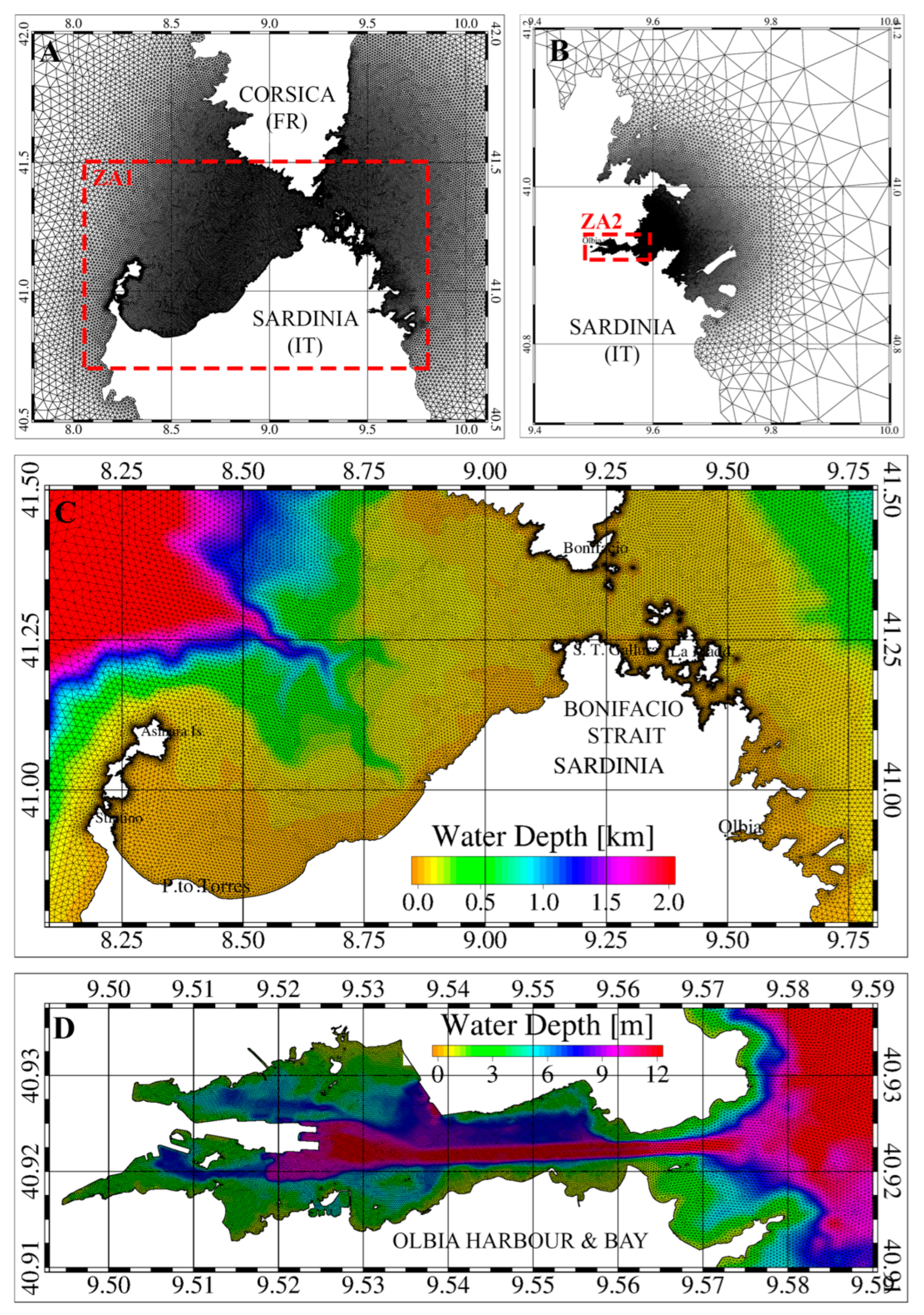
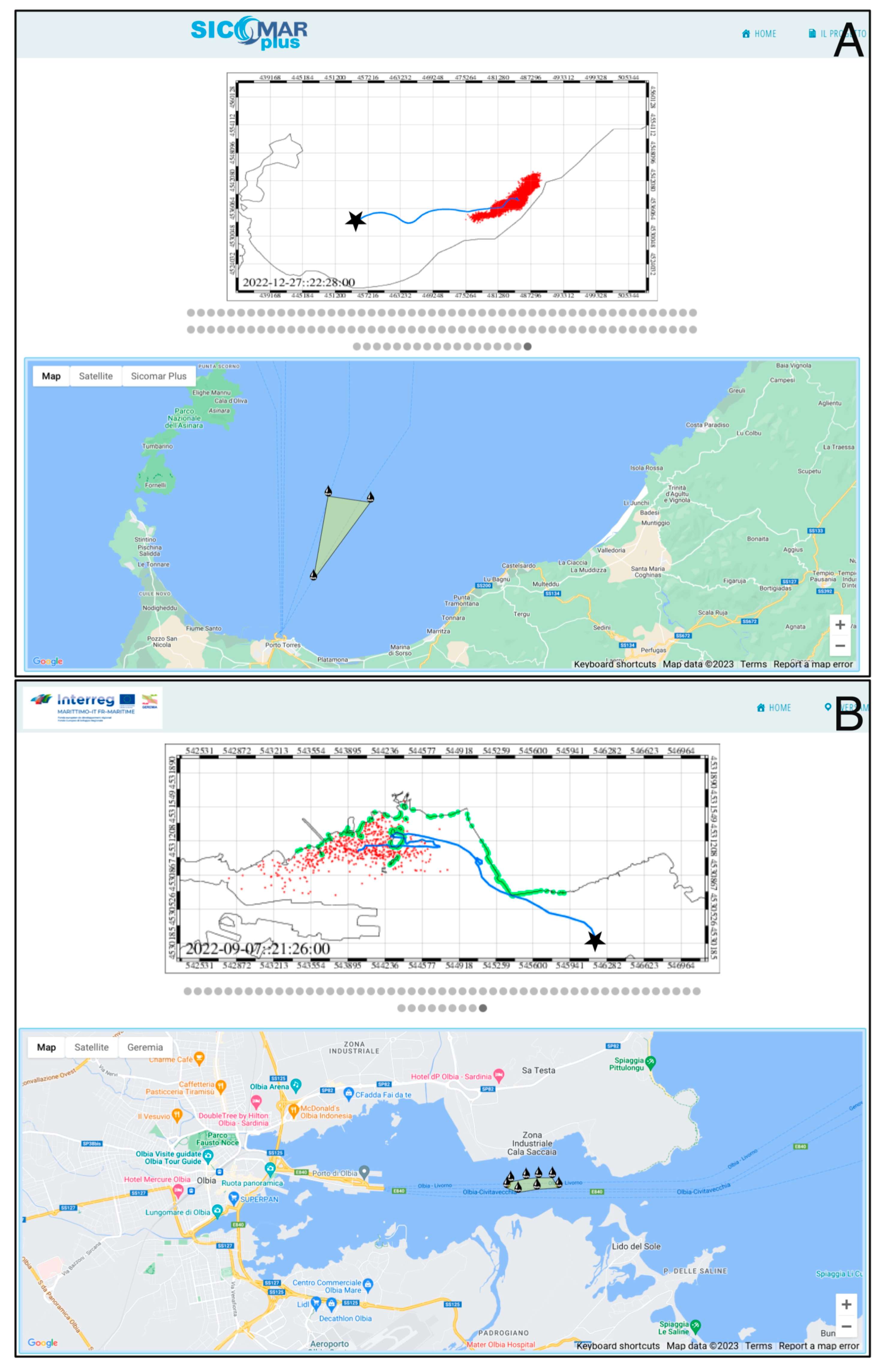

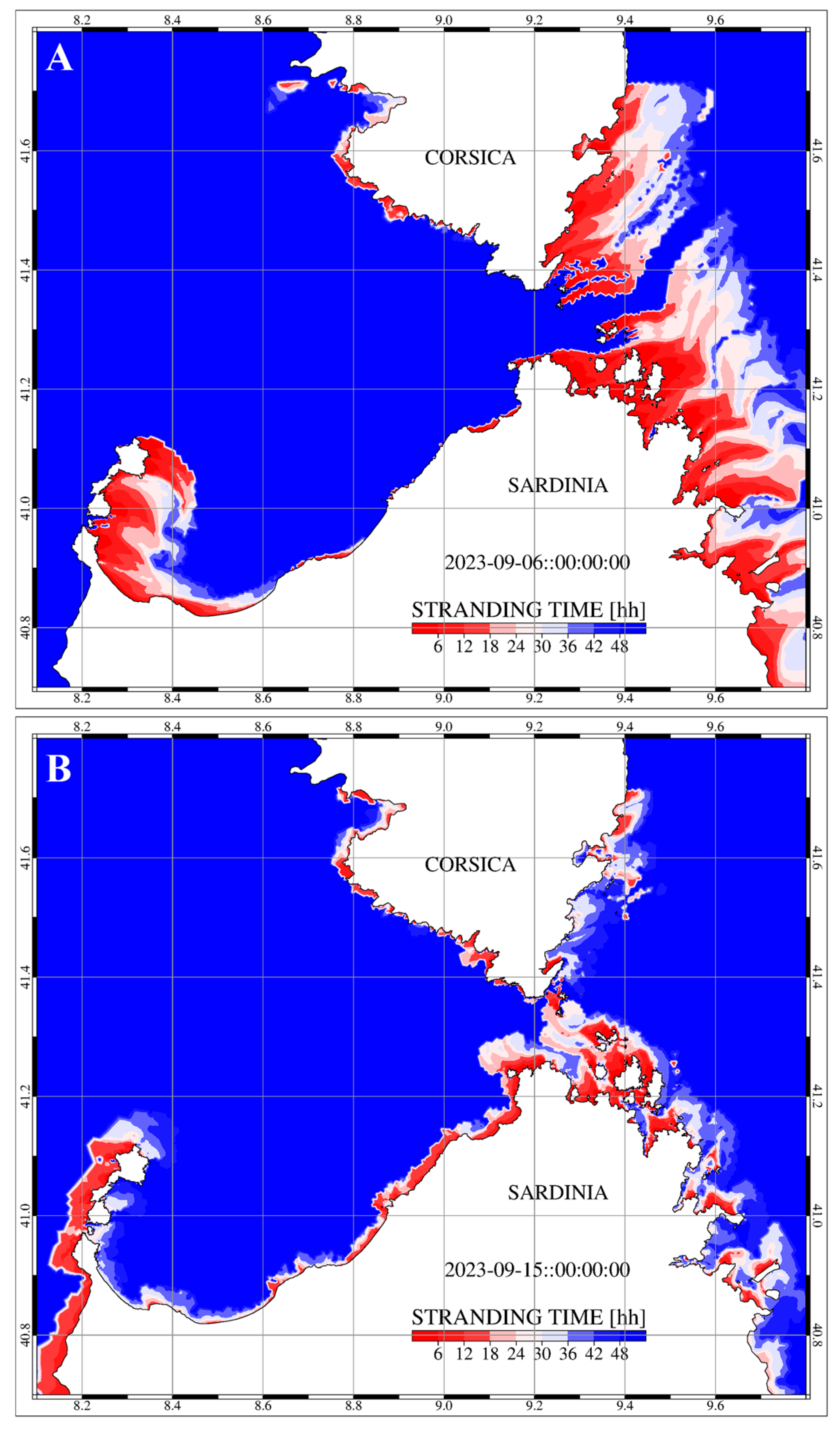
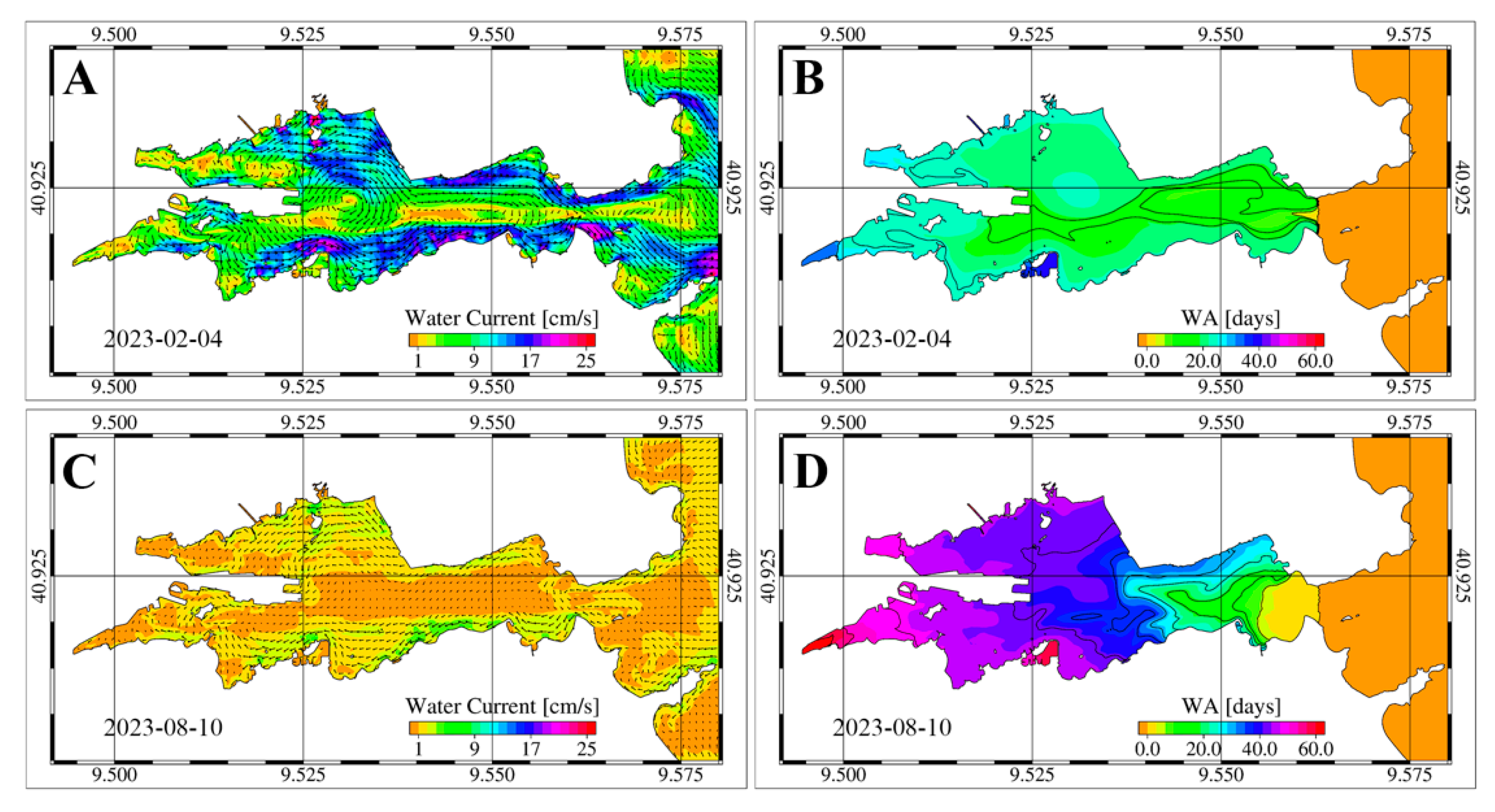
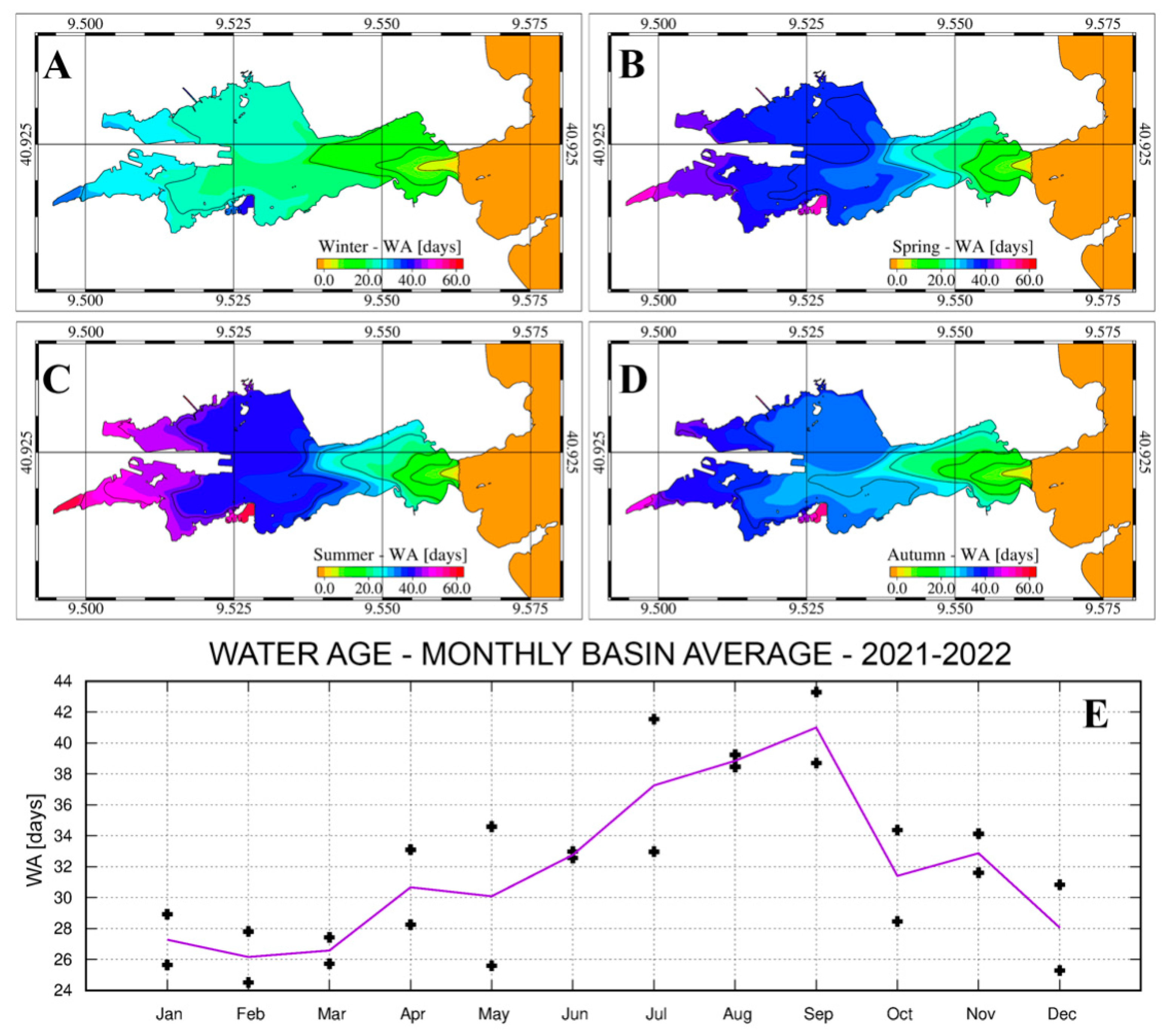
Disclaimer/Publisher’s Note: The statements, opinions and data contained in all publications are solely those of the individual author(s) and contributor(s) and not of MDPI and/or the editor(s). MDPI and/or the editor(s) disclaim responsibility for any injury to people or property resulting from any ideas, methods, instructions or products referred to in the content. |
© 2024 by the authors. Licensee MDPI, Basel, Switzerland. This article is an open access article distributed under the terms and conditions of the Creative Commons Attribution (CC BY) license (https://creativecommons.org/licenses/by/4.0/).
Share and Cite
Cucco, A.; Simeone, S.; Quattrocchi, G.; Sorgente, R.; Pes, A.; Satta, A.; Sinerchia, M.; Perilli, A.; Ribotti, A. Operational Oceanography in Ports and Coastal Areas, Applications for the Management of Pollution Events. J. Mar. Sci. Eng. 2024, 12, 380. https://doi.org/10.3390/jmse12030380
Cucco A, Simeone S, Quattrocchi G, Sorgente R, Pes A, Satta A, Sinerchia M, Perilli A, Ribotti A. Operational Oceanography in Ports and Coastal Areas, Applications for the Management of Pollution Events. Journal of Marine Science and Engineering. 2024; 12(3):380. https://doi.org/10.3390/jmse12030380
Chicago/Turabian StyleCucco, Andrea, Simone Simeone, Giovanni Quattrocchi, Roberto Sorgente, Andrea Pes, Andrea Satta, Matteo Sinerchia, Angelo Perilli, and Alberto Ribotti. 2024. "Operational Oceanography in Ports and Coastal Areas, Applications for the Management of Pollution Events" Journal of Marine Science and Engineering 12, no. 3: 380. https://doi.org/10.3390/jmse12030380
APA StyleCucco, A., Simeone, S., Quattrocchi, G., Sorgente, R., Pes, A., Satta, A., Sinerchia, M., Perilli, A., & Ribotti, A. (2024). Operational Oceanography in Ports and Coastal Areas, Applications for the Management of Pollution Events. Journal of Marine Science and Engineering, 12(3), 380. https://doi.org/10.3390/jmse12030380









